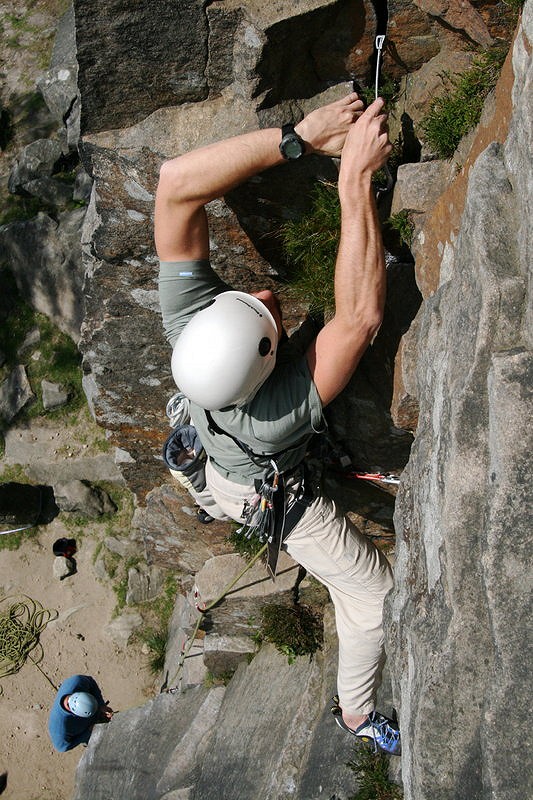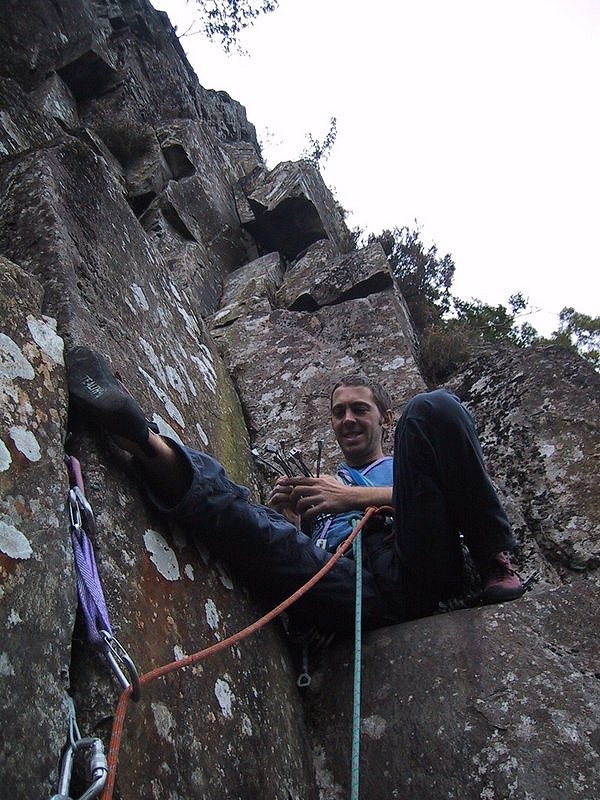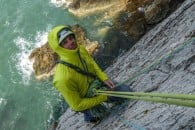
So there I was, a good way up and attempting the well protected crack line of 'Pulcherrime' at Burbage North. Endlessly groping for the perfect hand jam, and shaking like a shitting dog, I gave in and slumped onto the nearest runner. Which promptly pulled!
For me the punishment was hitting the deck from near the top of the route, heavily winding myself, and the embarrassment of my other fifteen year old “mates” taking the piss for weeks. Luckily, I was able to walk away with just a bruised ego.
Unfortunately, the ground is very close on the grit and on single pitch crags in general, and we all know that trying to fight gravity usually ends in a downward direction! Below are a few simple things to think about, they might just keep you safe on the crag:
Place Some Gear!
OK, fairly obvious, but putting in good gear with an appropriate spacing is going to keep you off the deck. Leading is all about making constant judgements on gear quality and the distance of any potential fall combined with the likelihood of taking flight. Remember to look down from time to time and judge how far you will go, taking into account rope stretch and the position of your belayer. Is it enough to keep you off the deck or away from that big ledge?
If a fall is likely, and the consequences of gravity are dangerous then you can always back off. Alternatively, good gear, an attentive belayer and some strong arms/good technique might encourage you to go for it.
On a short single pitch crag there is often only the top runner keeping you off the ground should you take that fall. If it pops either because it is just a bad placement, or badly placed, there will be more slack in the system. Make every runner a good one.
Critical Runners
Some routes will have 'critical runners'. These are runners that are crucial to protect the crux or tricky moves, which if missed could make the route much more serious. For example a classic gritstone VS might well be graded with this in mind, if you miss this runner either accidentally or otherwise, you might be looking at a considerably bolder (and higher grade) experience.
Unfortunately these runners also suffer from quite a lot of wear and tear, as they are often close to the crux. Cams and soft gritstone don't really mix with many placements getting worn with use. e.g. those on Flying Buttress Direct and The Tippler at Stanage Edge.
On some crags you might also find fixed gear in the form of pegs or stuck wires close to the crux. In many cases these will have been 'in-situ' for sometime and may have taken some punishment, resulting in them being prone to failure. As much as possible check the eye of pegs for corrosion, and have a good look at the point where it disappears into the rock. If in doubt back it up with natural protection.

Single pitch crags are often short and as such there is limited stretchy rope available in the system to absorb the force of small falls. This is at its most significant close to the first runners, as any fall will be short and there is minimal rope out. As such the force on that first runner can be correspondingly high as can the possibility of slamming into the rock.
Also using small wires such as RP's and “panic” cams etc can be useful, but having a small amount of rope in the system might mean that they are subjected to high forces; not great for marginal placements. Check out this recent BMC Technical Report from an incident at Burbage North.
Obviously sometimes there is no alternative and small wires are much better than nothing. In an effort to get one “bomber” piece it's definitely worth while trying to link lots of small wires together effectively sharing the load (aka “a mini bombshelter!”)
Long quickdraws or extenders will help the rope to run smoother, allowing a greater proportion of the rope to absorb the force of a fall, hence reducing the impact force on the runners. Save those short draws for sport cragging.
Belayer position
An attentive belayer is great for your confidence as well as your physical well being. Ideally they should be belaying close in to the crag to prevent any outward pull on the gear should a fall occur. I once watched in horror as somebody ran backwards to take in the slack for their leader “unzipping” the wires from the bottom upwards.
Being close-in to the base of the crag also prevents the possibility of being pulled into the crag which can introduce slack into the system. Obviously, this isn't good for the leader who can hit the deck but also for the second who can sustain injury from slamming into the crag.
Watch the rope
Pay attention to the position of the rope when leading. Try and avoid the rope running over the back of your leg or your thigh, which may result in you getting flipped upside down in a fall. Low down on a route this might mean getting your belayer to move out to the side slightly. The role of the belayer isn't a static one. Be prepared to move to the side, to flick the rope, to remind your leader that they have the rope behind their leg etc.
Rope System
It's definitely worth thinking about the rope system you use on short single pitch crags; with many people choosing to use two half ropes for those weird lines. Many Gritstone crags have nice horizontal breaks allowing you to place gear creating a baby bouncer before the crux moves. In many cases this will also double your protection opportunities.
As half ropes get thinner you also need to be aware that they will often stretch more, and friction in the system will be much reduced. This is great if you are climbing in winter as it reduces the impact force on the gear. However, on those small single pitch crags I would be more inclined to use a traditional half rope between 8.4-9mm. Save those skinny 8.1mm for the winter thin face routes on Ben Nevis.
Wear a helmet
My last point is to consider wearing a helmet. For single pitch cragging I favour a modern foam model e.g Meteor, which offer protection if you strike your head in a fall. These offer better protection in this situation than many other helmets as well as protecting you from that falling Hex 11.
James Thacker is a Mountaineering Instructor (MIC) running climbing courses in the Peak District and UK wide. James is often to be found on the grit but is also keen on getting away to Scotland for winter suffering, as well as making a few personal visits to the Alps. Find out more about James Thacker Mountaineering.
Also a member of Edale Mountain Rescue Team, James can be found running up to the bottom of Stanage Edge on a busy weekend.
James is sponsored by Haglofs



Comments